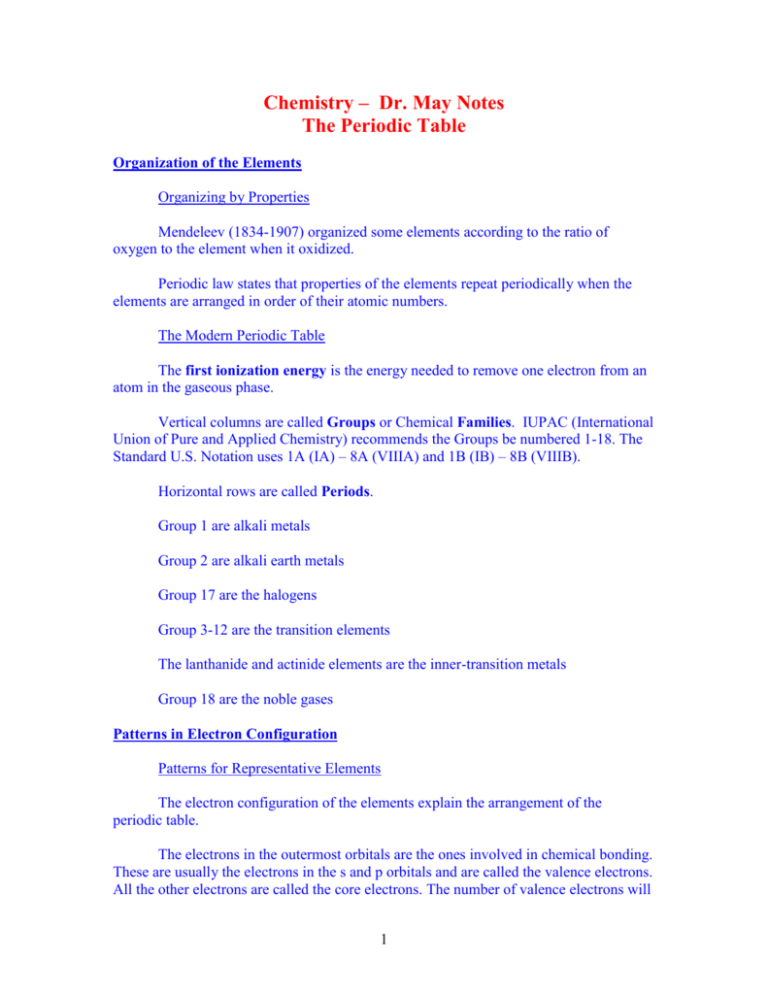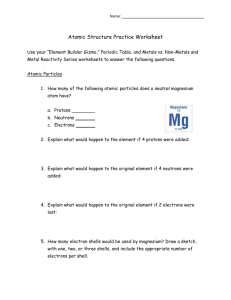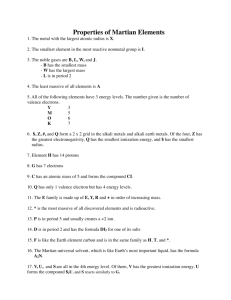Periodic Table
advertisement

Chemistry – Dr. May Notes The Periodic Table Organization of the Elements Organizing by Properties Mendeleev (1834-1907) organized some elements according to the ratio of oxygen to the element when it oxidized. Periodic law states that properties of the elements repeat periodically when the elements are arranged in order of their atomic numbers. The Modern Periodic Table The first ionization energy is the energy needed to remove one electron from an atom in the gaseous phase. Vertical columns are called Groups or Chemical Families. IUPAC (International Union of Pure and Applied Chemistry) recommends the Groups be numbered 1-18. The Standard U.S. Notation uses 1A (IA) – 8A (VIIIA) and 1B (IB) – 8B (VIIIB). Horizontal rows are called Periods. Group 1 are alkali metals Group 2 are alkali earth metals Group 17 are the halogens Group 3-12 are the transition elements The lanthanide and actinide elements are the inner-transition metals Group 18 are the noble gases Patterns in Electron Configuration Patterns for Representative Elements The electron configuration of the elements explain the arrangement of the periodic table. The electrons in the outermost orbitals are the ones involved in chemical bonding. These are usually the electrons in the s and p orbitals and are called the valence electrons. All the other electrons are called the core electrons. The number of valence electrons will 1 determine the activity of the element, will determine what ion it forms, and are the total of the “outermost” s and p electrons (2s + 2p, 3s + 3p, 4s + 4p, etc.). The number of valence electrons can be between 1 and 8. The oxidation number is the number of valence electrons lost or gained during a chemical reaction. The ion will have eight valence electrons, like the nearest inert gas (The Octet Rule). As a rule, metals lose valence electrons and non-metals gain electrons to form ions. The dependable oxidation numbers are defined by “Dr. May’s Always Rule”: Alkali Metals are +1, Alkaline Earth Metals are +2, The Boron Family elements are +3, The Oxygen Family elements are –2, and The Halogens are –1. The Transition Metals can almost always have +2 as one of their oxidation Numbers. Patterns for Representative Element Ions All alkali metals (Group 1) have one electron in the outer s-orbital. Na Na+1 1s22s22p63s1 designated [Ne] 3s1 1s22s22p6 which is the same as Neon making it isoelectronic. All alkali earth metals (Group 2) have two electrons in the outer s-orbital Mg 1s22s22p63s2 designated [Ne] 3s2 Mg+2 1s22s22p6 which is the same as Neon making it isoelectronic. All halogens (Group 17) have seven valence electrons F 1s22s22p5 designated as [He] 2s22p5 F 1s22s22p6 which is the same as Neon making it isoelectronic Patterns for Transition Elements and Ions Copper, Chromium, and Iron are three exceptions in filling up orbitals or forming ions as shown in the partial table below. Atom or Ion 1s 2s Cr Cr +6 Cr +4 Fe Fe +2 Fe +3 Cu Cu +1 Cu +2 2p 3s 3p 4s 2 3d 4p 5s Periodic Trends Atomic and Ionic Radii Trends The atomic radius decreases as you go across a period. The atomic radius increases as you go down a group. Ionization Energy (1st IE) Element + ionization energy Ion + + e 1st IE generally increases as we go across a row 1st IE decreases as you go down a column As we move right across a period, Atomic numbers increase Atomic radii decrease (more + charge in nucleus) Ionization energies increase (smaller and more + charge) Metallic properties decrease As we move down a group, Atomic numbers increase Atomic radii increase (electrons farther from the nucleus) Ionization energies decrease (larger size and shielding) Metallic properties increase The ionization energy of the second electron (2nd IE) is always larger than the first (1st IE). 40 +2 Atoms and their ions can be represented as shown: Ca 20 Where 40 is the mass number (protons plus neutrons), 20 is the atomic number (protons) and the +2 (the ionic charge) is the number of the 20 electrons lost to form the ion, leaving 18 electrons. If the ionic charge is negative (), electrons have been gained. If the ionic charge is positive (+), electrons have been lost. 3



